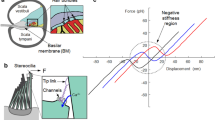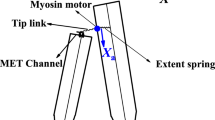Abstract
This study presents an initial study on the bifurcation analysis of bistable oscillator dynamics for human hair-cell bundle structures. The hair-cell bundles within the human cochlea possess highly nonlinear stiffness while sound transmission. To better understand this bistable oscillator dynamics, this study focused on the bifurcation phenomena using the Floquet theory. To define the bifurcations associated with super- and sub-harmonic resonances, the harmonic balance method (HBM) was first utilized with Hill’s method, for determining the dynamics stability conditions. In addition, the Floquet multipliers were mapped to examine their relationship with the bifurcation characteristics. To examine the bifurcation characteristics, only the Floquet multipliers associated with unstable conditions were selected because those associated with stable conditions were decaying terms. Then, the complex values of the Floquet multipliers at specific frequency locations were compared with the bifurcations’ characteristics. When numerically calculated bifurcations were compared with the results obtained using the HBM, mapping the Floquet multipliers was sufficient for predicting the bifurcations of a biomimetic system inspired by the hair-cell bundle structure. This study suggests practical techniques for employing the HBM with Hill’s method by mapping the Floquet multipliers to investigate complex nonlinearities that occur in bistable-stiffness systems.














Similar content being viewed by others
Data availability
The data used to support this study are included in this article.
References
Kim, H., Song, T., Ahn, K.H.: Sharply tuned small force measurement with a biomimetic sensor. Appl. Phys. Lett. 98, 013704 (2011)
Harne, R.L., Wang, K.W.: A review of the recent research on vibration energy harvesting via bistable systems. Smart Mater. Struct. 22, 023001 (2013)
Gillespie, P.G., Muller, U.: Mechanotransduction by hair cells: models, molecules, and mechanisms. Cell 139, 33–44 (2009)
Hudspeth, A.J.: How the ear’s works work: mechanoelectrical transduction and amplification by hair cells. C. R. Biol. 328, 155–162 (2005)
Martin, P., Mehta, A.D., Hudspeth, A.J.: Negative hair-bundle stiffness betrays a mechanism for mechanical amplification by the hair cell. Proc. Natl. Acad. Sci. 97, 12026–12031 (2000)
Chen, G., Wu, H., Li, B., Wang, M.Y.: Fully compliant bistable mechanisms with enhanced pitch stiffness. Mech. Syst. Signal Process. 161, 107926 (2021)
Li, M., Jing, X.: A bistable X-structured electromagnetic wave energy converter with a novel mechanical-motion-rectifier: design, analysis, and experimental tests. Energy Convers. Manag. 244, 114466 (2021)
Dalela, S., Balaji, P.S., Jena, D.P.: Design of a metastructure for vibration isolation with quasi-zero-stiffness characteristics using bistable curved beam. Nonlinear Dyn. 108, 1931–1971 (2022)
Yan, B., Yu, N., Ma, H., Wu, C.: A theory for bistable vibration isolators. Mech. Syst. Signal Process. 167, 108507 (2022)
Nadkarni, N., Daraio, C., Kochmann, D.M.: Dynamics of periodic mechanical structures containing bistable elastic elements: from elastic to solitary wave propagation. Phys. Rev. E 90, 023204 (2014)
Le, T.D., Ahn, K.K.: Experimental investigation of a vibration isolation system using negative stiffness structure. Int. J. Mech. Sci. 70, 99–112 (2013)
Kim, G.W., Kim, J.: Compliant bistable mechanism for low frequency vibration energy harvester inspired by auditory hair bundle structures. Smart Mater. Struct. 22, 014005 (2013)
Afzali, F., Acar, G.D., Feeny, B.F.: A Floquet-based analysis of parametric excitation through the damping coefficient. J. Vib. Acoust. Trans. ASME 143, 041003 (2021)
Detroux, T., Renson, L., Masset, L., Kerschen, G.: The harmonic balance method for bifurcation analysis of large-scale nonlinear mechanical systems. Comput. Methods Appl. Mech. Eng. 296, 18–38 (2015)
Miguel, L.P., Teloli, R.O., Silva, S.: Some practical regards on the application of the harmonic balance method for hysteresis models. Mech. Syst. Signal Process. 143, 106842 (2020)
Xie, L., Baguet, S., Prabel, B., Dufour, R.: Bifurcation tracking by Harmonic Balance Method for performance tuning of nonlinear dynamical systems. Mech. Syst. Signal Process. 88, 445–461 (2017)
Berns, D.W., Moiola, J.L., Chen, G.: Detecting period-doubling bifurcation: an approximate monodromy matrix approach. Automatica 37, 1787–1795 (2001)
Guillot, L., Lazarus, A., Thomas, O., Vergez, C., Cochelin, B.: A purely frequency based Floquet-Hill formulation for the efficient stability computation of periodic solutions of ordinary differential systems. J. Comput. Phys. 416, 109477 (2020)
Guskov, M., Thouverez, F.: Harmonic balance-based approach for quasi-periodic motions and stability analysis. J. Vib. Acoust. Trans. ASME 134(3), 031003 (2012)
Yoon, J.Y., Singh, R.: Effect of multi-staged clutch damper characteristics on transmission gear rattle under two engine conditions. Proc. Inst. Mech. Eng. Pt. D J. Automobile Eng. 227(9), 1273–1294 (2013)
Yoon, J.Y., Yoon, H.S.: Nonlinear frequency response analysis of a multistage clutch damper with multiple nonlinearities. J. Comput. Nonlinear Dyn. 9(3), 031007 (2014)
Kim, T.C., Rook, T.E., Singh, R.: Super- and sub-harmonic response calculation for a torsional system with clearance nonlinearity using the harmonic balance method. J. Sound Vib. 281, 965–993 (2005)
Duan, C., Rook, T.E., Singh, R.: Sub-harmonic resonance in a nearly pre-loaded mechanical oscillator. Nonlinear Dyn. 50, 639–650 (2007)
Yoon, J.Y., Kim, B.: Sub-Harmonic response analysis of nonlinear dynamic behaviors induced by piecewise-type nonlinearities in a torsional vibratory system. Appl. Sci. 12, 1845 (2022)
Yoon, J.Y., Kim, B.: Examination of sub-harmonic responses along with various initial conditions induced by multi-staged clutch damper system. Sci. Rep. 12, 11339 (2022)
Yoon, J.Y., Kim, B.: Stability and bifurcation analysis of super- and sub-harmonic responses in a torsional system with piecewise-type nonlinearities. Sci. Rep. 11, 23601 (2021)
Yoon, J.Y., Kim, B.: Investigation of complex nonlinear dynamic behaviors observed in a simplified driveline system with multistage clutch dampers. Sci. Rep. 12, 9834 (2022)
Deconinck, B., Nathan Kutz, J.: Computing spectra of linear operators using the Floquet-Fourier-Hill method. J. Comput. Phys. 219, 296–321 (2006)
Jordan, D.W., Smith, P.: Nonlinear Ordinary Differential Equations. Oxford University Press (2004)
Dormand, J.R., Prince, P.J.: A family of embedded Runge-Kutta formulae. J. Comput. Appl. Math. 6(1), 19–26 (1980)
Funding
This research was supported by an Incheon National University Research Grant in 2022 (20220054) and the Basic Science Research Program through the National Research Foundation of Korea (NRF), funded by the Ministry of Education (NRF-2021R1A2C1003411).
Author information
Authors and Affiliations
Corresponding author
Ethics declarations
Conflict of interest
The authors declare that authors have no competing interests.
Additional information
Publisher's Note
Springer Nature remains neutral with regard to jurisdictional claims in published maps and institutional affiliations.
Appendix A
Appendix A
Derivations of the Hill’s method.
Using Taylor’s expansion, the nonlinear terms can be simplified, as follows:
By substituting Eq. (11) into Eq. (10), the overall equation can be summarized, as follows:
In the above, the first term is \(\left[ {m\underline {{\bf{\ddot{x}}}_{{\bf{bs}}} } \left( t \right) + c\underline {{\bf{\dot{x}}}_{{\bf{bs}}} } \left( t \right) + \underline {{\bf{F}}_{\bf{S}} } \left( {\underline {{\bf{x}}_{{\bf{bs}}} } \left( t \right)} \right)} \right] - \underline {{\bf{F}}_{\bf{b}} } \left( t \right) = \underline {\bf{0}}\), because it is the exact solution after the perturbation decays completely. The second term in Eq. (12) should be satisfied and the first and second derivatives of the perturbation \(\underline {\bf{\xi }} \left( {\bf{t}} \right) = \underline {\bf{p}} \left( {\bf{t}} \right)e^{\lambda t}\) are obtained as \( \underline{\dot{\xi }} \left( t \right) = \underline{\dot{p}} \left( t \right)e^{\lambda t} + \lambda \underline{p} \left( t \right)e^{\lambda t} t \) and \( \underline {\ddot{\xi }} \left( t \right) = \underline {\ddot{p}} \left( t \right)e^{\lambda t} + 2\lambda \underline {\dot{p}} \left( t \right)e^{\lambda t} + \lambda ^2 \underline p \left( t \right)e^{\lambda t} \) respectively, and are substituted into the perturbation terms of Eq. (12), as follows:
Based on Eqs. (4) and (5), \(\underline {\bf{p}} \left( {\bf{t}} \right)\) can be expressed using the Galerkin scheme, by means of the Fourier transformation. Thus, let the series of the time history of \(\underline {\bf{p}} \left( {\bf{t}} \right)\) be \(\underline {\bf{p}} \left( {\bf{t}} \right) = \underline{\underline {\bf{\mathfrak{I}}}} \underline {{\bf{p}}_{\bf{c}} }\), \(\underline {{\bf{\dot{p}}}} \left( {\bf{t}} \right) = \varpi \underline{\underline {\bf{\mathfrak{I}}}} \underline{\underline {\bf{D}}}^{\prime} \underline {{\bf{p}}_{\bf{c}} }\), and \( \left. {\frac{{\partial \underline {F_S } }}{{\partial \underline x \left( {t_i } \right)}}} \right| \). Here, \(\left. {\frac{{\partial \underline {{\bf{F}}_{\bf{S}} } }}{{\partial \underline {\bf{x}} }}} \right|_{\underline {\bf{x}} = \underline {{\bf{x}}_{{\bf{bs}}} } }\) is determined from the predictor and corrector concepts for each iteration using \(\left. {\frac{{\partial \underline {{\bf{F}}_{\bf{S}} } }}{{\partial \underline {\bf{x}} \left( {t_i } \right)}}} \right|\)(i = 0,1,···, j-2, j-1). Thus, Eq. (13) is organized with respect to λ by ignoring the common factor \(\underline {{\bf{p}}_{\bf{c}} }\), as follows:
Here, the pseudo-inverse matrix \(\underline{\underline {\bf{\mathfrak{I}}}}^+\) is defined as  . Because \(\underline{\underline {\bf{\mathfrak{I}}}} \ne \underline{\underline {\bf{0}}}\), the eigenvalues λi are estimated using Eq. (14), as follows:
. Because \(\underline{\underline {\bf{\mathfrak{I}}}} \ne \underline{\underline {\bf{0}}}\), the eigenvalues λi are estimated using Eq. (14), as follows:

Rights and permissions
Springer Nature or its licensor (e.g. a society or other partner) holds exclusive rights to this article under a publishing agreement with the author(s) or other rightsholder(s); author self-archiving of the accepted manuscript version of this article is solely governed by the terms of such publishing agreement and applicable law.
About this article
Cite this article
Kim, G.W., Yoon, J.Y. Bifurcation analysis of bistable oscillator dynamics for human hair-cell bundle structures by mapping the Floquet multipliers. Nonlinear Dyn 112, 11383–11398 (2024). https://doi.org/10.1007/s11071-024-09560-5
Received:
Accepted:
Published:
Issue Date:
DOI: https://doi.org/10.1007/s11071-024-09560-5




